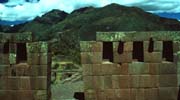
The highest grade of Incan masonry was employed in the buildings of
the middle ruins of Pisaq. The projecting round cylinders are roof tie
downs. This view faces across the valley (with Pisaq village below)
towards Cuzco.
|

The complex of buildings of the middle ruin surround the Intihuatani,
the "Hitching Post of the Sun." The remains of the stone post are visible
atop the rock above center on the left. This view faces across the side
canyon in the direction of the lower ruins. Note the fields on the mountainside.
|

This close-up of the Intihuatani shows how it was broken off. The Spanish
conquerors destroyed every Intihuatani they found.
The confluence of the side canyon and the Valley of the Incas is visible
below. Pisaq village is on the valley floor just downstream from the
confluence. The lower ruins are visible in the center left of this view.
The close-up of the lower ruins on the right has the same background
as this view.
|

The lower ruins with the valley floor and fields across the side canyon
as background. The grade of masonry in the lower ruins does not equal
that surrounding the Intihuatani.
|

One of the dangers of farming in Perú is falling out of your
fields! Note the terracing in the canyons all the way to the top of
the mountain. This is the view from Pisaq village on the valley floor.
The Inca ruins are to the right of this view.
|

The Andean people domesticated llamas and alpacas at an early date,
long before the Inca civilization consolidated the polities of the region.
Llamas were the only beast of burden in all the Americas. Their course
hair was is woven into cargo bags they transport. They will carry up
to about 50 pounds, and if overloaded simply sit down. They are well
adapted to the steep mountains.
Alpacas are raised for their fine hair and for meat. They are smaller
than alpacas and have shorter faces.
|